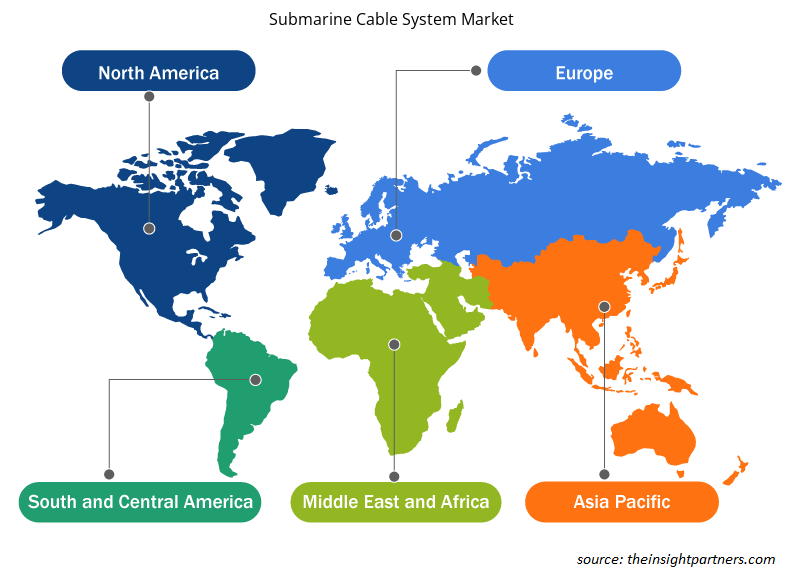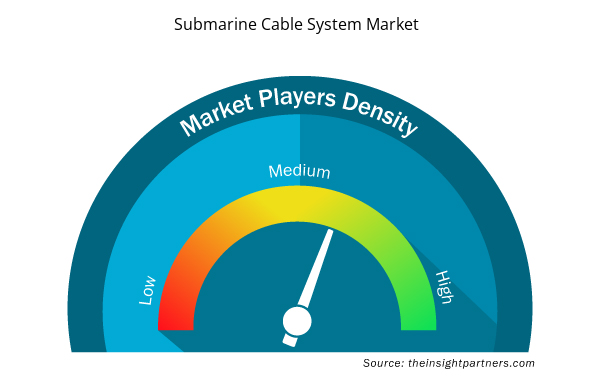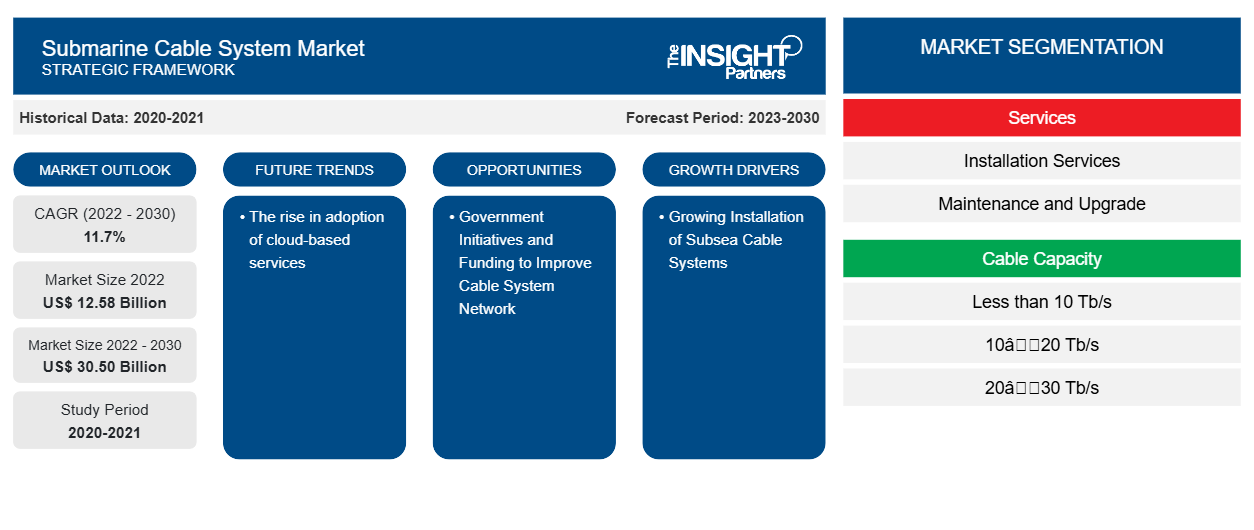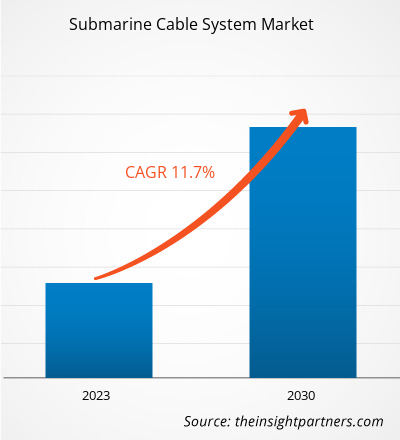海底ケーブルシステムの市場規模は、2022年の125億8,000万米ドルから2030年には305億米ドルに達すると予測されています。市場は2022年から2030年の間に11.7%のCAGRを記録すると予想されています。クラウドベースのサービスの採用の増加は、引き続き市場の主要なトレンドとなると思われます。
海底ケーブルシステム市場分析
海底ケーブルシステムの設置の増加とデータトラフィックの増加が市場を牽引しています。洋上風力発電への投資が急増しているため、予測期間中に市場は成長すると予想されています。さらに、ケーブルシステムネットワークを改善するための政府の取り組みと資金提供、およびHVDC送電技術に基づくプロジェクトの増加により、市場に有利な機会が生まれています。
海底ケーブルシステム市場の概要
海底ケーブルシステムは、異なる地域を接続し、シームレスな通信とデータ転送を提供するために海の下に敷設されたケーブルのインフラストラクチャです。これらのシステムは、グローバルな接続性を促進する上で重要な役割を果たしており、通信およびインターネット部門の不可欠な要素です。比類のない信頼性、低遅延、高帯域幅を提供するため、リアルタイムのデータ交換、クラウドコンピューティング、オンラインコラボレーションに依存する企業に最適です。さらに、海底ケーブルシステムは国際通信に不可欠であり、国や大陸間で大量のデータを送信できます。
要件に合わせてレポートをカスタマイズする
このレポートの一部、国レベルの分析、Excelデータパックなど、あらゆるレポートを無料でカスタマイズできます。また、スタートアップや大学向けのお得なオファーや割引もご利用いただけます。
- このレポートの主要な市場動向を入手してください。この無料サンプルには、市場動向から見積もりや予測に至るまでのデータ分析が含まれます。
海底ケーブルシステム市場の推進要因と機会
海底ケーブルシステムの設置増加が市場を有利に導く
2022年4月、Googleは画期的なTopaz海底ケーブルを発表し、アジアとカナダ間の初の接続を確立しました。Topazケーブルは印象的なインフラストラクチャを誇り、合計16本のファイバーペアを収容し、240Tb/sという驚異的な容量を提供します。波長選択スイッチ(WSS)などの最先端技術が組み込まれており、動的なスペクトル割り当てを可能にし、ルーティングの柔軟性と回復力を強化します。著名なサービスプロバイダーによる取り組みは、市場の成長の大きな原動力となっています。
ケーブルシステムネットワークの改善に向けた政府の取り組みと資金提供
英国政府は、海底ケーブル業界と積極的に協力し、中断のない運用を確保しています。これには、このダイナミックな環境における厳しい移動制限の可能性に備えて将来の計画を立てることも含まれます。英国の政府機関と民間企業は、企業を支援し経済を守るために努力しています。たとえば、2023年11月には、エネルギーおよび通信ケーブルシステム部門の世界的リーダーであるPrysmian Groupが、約9億米ドル相当の契約を獲得しました。この契約は、英国の送電網所有者であるSP Transmission plcとNational Grid Electricity Transmission plcの合弁会社であるEastern Green Link 1 Limitedによって締結されました。この契約には、スコットランドとイングランドを結ぶ重要なネットワーク開発プロジェクト向けのケーブルシステムの提供が含まれます。
海底ケーブルシステム市場レポートのセグメンテーション分析
海底ケーブル システム市場分析の導出に貢献した主要なセグメントは、コンポーネントと採掘タイプです。
- サービスに基づいて、海底ケーブルシステム市場は設置サービスと保守およびアップグレードに分かれています。設置サービスセグメントは2022年に大きな市場シェアを占めました。
- ケーブル容量別に見ると、市場は10Tb/s未満、10~20Tb/s、20~30Tb/s、30Tb/s超に分類されます。2022年には、20~30Tb/sセグメントがより大きな市場シェアを占めました。
- アプリケーションに基づいて、市場は通信とエネルギーおよび電力に分かれています。通信セグメントは2022年に大きな市場シェアを占めました。
- タイプ別に見ると、市場はシングルコアとマルチコアに分かれています。2022年にはシングルコアセグメントがより大きな市場シェアを占めました。
地域別海底ケーブルシステム市場シェア分析
海底ケーブルシステム市場レポートの地理的範囲は、主に北米、アジア太平洋、ヨーロッパ、中東およびアフリカ、南米および中米の 5 つの地域に分かれています。
ヨーロッパの市場は予測期間中に拡大すると予測されています。インド政府は、インドのデジタル経済を促進するために、インドにおける海底ケーブル陸揚げのライセンス枠組みや規制メカニズムなど、海底ケーブルシステムの政策の見直しに注力しています。インドの海底ケーブルシステムの容量は、ここ数年で目覚ましい成長を遂げ、大幅に増加しています。インドの電気通信規制当局が収集したデータによると、容量は2016年の9,137 Gbit/sから2022年には83,000 Gbit/sに急増しています。この容量の急増は、主にムンバイとチェンナイにある14のケーブル陸揚げ局から運用されている17の海底ケーブルの設置と管理によって可能になりました。海底容量のこの大幅な増加は、インドの通信インフラの拡大と高速インターネット接続の高まる需要への対応への取り組みを反映しています。容量の増加は、企業や個人の高まるデジタルニーズをサポートするとともに、この国を世界の通信分野における主要プレーヤーにすることになります。
海底ケーブルシステム市場の地域別分析
予測期間を通じて海底ケーブル システム市場に影響を与える地域的な傾向と要因は、Insight Partners のアナリストによって徹底的に説明されています。このセクションでは、北米、ヨーロッパ、アジア太平洋、中東、アフリカ、南米、中米にわたる海底ケーブル システム市場のセグメントと地理についても説明します。

- 海底ケーブルシステム市場の地域別データを入手
海底ケーブルシステム市場レポートの範囲
| レポート属性 | 詳細 |
|---|---|
| 2022年の市場規模 | 125.8億米ドル |
| 2030年までの市場規模 | 305億米ドル |
| 世界のCAGR(2022年 - 2030年) | 11.7% |
| 履歴データ | 2020-2021 |
| 予測期間 | 2023-2030 |
| 対象セグメント | サービス別
|
| 対象地域と国 | 北米
|
| 市場リーダーと主要企業プロフィール |
|
海底ケーブルシステム市場のプレーヤー密度:ビジネスダイナミクスへの影響を理解する
海底ケーブル システム市場は、消費者の嗜好の変化、技術の進歩、製品の利点に対する認識の高まりなどの要因により、エンド ユーザーの需要が高まり、急速に成長しています。需要が高まるにつれて、企業は提供内容を拡大し、消費者のニーズを満たすために革新し、新たなトレンドを活用し、市場の成長をさらに促進しています。
市場プレーヤー密度とは、特定の市場または業界内で活動している企業または会社の分布を指します。これは、特定の市場スペースに、その規模または総市場価値と比較して、どれだけの競合相手 (市場プレーヤー) が存在するかを示します。
海底ケーブルシステム市場で事業を展開している主要企業は次のとおりです。
- 住友電気工業株式会社
- サブコム LLC
- プリスミアン SpA
- アルカテル海底ネットワーク
- ネクサンスSA
- NEC株式会社
免責事項:上記の企業は、特定の順序でランク付けされていません。

- 海底ケーブルシステム市場のトップキープレーヤーの概要を入手
海底ケーブルシステム市場のニュースと最近の動向
海底ケーブル システム市場は、主要な企業出版物、協会データ、データベースなどの一次調査と二次調査を経て定性的および定量的データを収集することで評価されます。海底ケーブル システム市場の動向のいくつかを以下に示します。
- WSense と Alcatel Submarine Networks (ASN) は、次世代の水中無線通信システムを構築するための覚書 (MOU) を締結しました。(出典: Nokia 傘下の Alcatel Submarine Networks、企業 Web サイト、2024 年 1 月)
海底ケーブルシステム市場レポートの対象範囲と成果物
「海底ケーブルシステム市場規模と予測(2020〜2030年)」レポートでは、以下の分野をカバーする市場の詳細な分析を提供しています。
- 対象範囲に含まれるすべての主要市場セグメントについて、世界、地域、国レベルでの海底ケーブルシステム市場規模と予測
- 海底ケーブルシステム市場の動向、推進要因、制約、主要な機会などの市場動向
- 詳細なPEST/ポーターの5つの力とSWOT分析
- 主要な市場動向、世界および地域の枠組み、主要プレーヤー、規制、最近の市場動向を網羅した海底ケーブルシステム市場分析
- 市場集中、ヒートマップ分析、主要プレーヤー、海底ケーブルシステム市場の最近の動向を網羅した業界の状況と競争分析
- 詳細な企業プロフィール
- 過去2年間の分析、基準年、CAGRによる予測(7年間)
- PEST分析とSWOT分析
- 市場規模価値/数量 - 世界、地域、国
- 業界と競争環境
- Excel データセット



Report Coverage
Revenue forecast, Company Analysis, Industry landscape, Growth factors, and Trends

Segment Covered
This text is related
to segments covered.

Regional Scope
North America, Europe, Asia Pacific, Middle East & Africa, South & Central America

Country Scope
This text is related
to country scope.
よくある質問
The global submarine cable system market is estimated to register a CAGR of 11.7% during the forecast period 2022–2030.
The key players holding majority shares in the global submarine cable system market are Sumitomo Electric Industries Ltd, SubCom, LLC, Prysmian SpA, Alcatel Submarine Networks, Nexans SA, NEC Corp, Mitsubishi Electric Corp, HMN Technologies Co., Ltd., Fujitsu Ltd, and Vodafone Group Plc.
The global submarine cable system market is expected to reach US$ 30.50 billion by 2030.
Asia Pacific dominated the submarine cable system market in 2022.
The Rise in adoption of cloud-based services to play a significant role in the global submarine cable system market in the coming years.
The growing installation of subsea cable systems and a rise in data traffic are the major factors that propel the global submarine cable system market.
Trends and growth analysis reports related to Electronics and Semiconductor : READ MORE..
The List of Companies - Submarine Cable Systems Market
- Fujitsu Limited
- Hawaiki Cable Limited
- HMN Technologies
- Mitsubishi Electric Corporation
- NEC Corporation
- Nexans Sa
- Nokia Corporation
- Prysmian Group
- Subcom, Llc
- Sumitomo Electric Industries, Ltd.
The Insight Partners performs research in 4 major stages: Data Collection & Secondary Research, Primary Research, Data Analysis and Data Triangulation & Final Review.
- Data Collection and Secondary Research:
As a market research and consulting firm operating from a decade, we have published and advised several client across the globe. First step for any study will start with an assessment of currently available data and insights from existing reports. Further, historical and current market information is collected from Investor Presentations, Annual Reports, SEC Filings, etc., and other information related to company’s performance and market positioning are gathered from Paid Databases (Factiva, Hoovers, and Reuters) and various other publications available in public domain.
Several associations trade associates, technical forums, institutes, societies and organization are accessed to gain technical as well as market related insights through their publications such as research papers, blogs and press releases related to the studies are referred to get cues about the market. Further, white papers, journals, magazines, and other news articles published in last 3 years are scrutinized and analyzed to understand the current market trends.
- Primary Research:
The primarily interview analysis comprise of data obtained from industry participants interview and answers to survey questions gathered by in-house primary team.
For primary research, interviews are conducted with industry experts/CEOs/Marketing Managers/VPs/Subject Matter Experts from both demand and supply side to get a 360-degree view of the market. The primary team conducts several interviews based on the complexity of the markets to understand the various market trends and dynamics which makes research more credible and precise.
A typical research interview fulfils the following functions:
- Provides first-hand information on the market size, market trends, growth trends, competitive landscape, and outlook
- Validates and strengthens in-house secondary research findings
- Develops the analysis team’s expertise and market understanding
Primary research involves email interactions and telephone interviews for each market, category, segment, and sub-segment across geographies. The participants who typically take part in such a process include, but are not limited to:
- Industry participants: VPs, business development managers, market intelligence managers and national sales managers
- Outside experts: Valuation experts, research analysts and key opinion leaders specializing in the electronics and semiconductor industry.
Below is the breakup of our primary respondents by company, designation, and region:

Once we receive the confirmation from primary research sources or primary respondents, we finalize the base year market estimation and forecast the data as per the macroeconomic and microeconomic factors assessed during data collection.
- Data Analysis:
Once data is validated through both secondary as well as primary respondents, we finalize the market estimations by hypothesis formulation and factor analysis at regional and country level.
- Macro-Economic Factor Analysis:
We analyse macroeconomic indicators such the gross domestic product (GDP), increase in the demand for goods and services across industries, technological advancement, regional economic growth, governmental policies, the influence of COVID-19, PEST analysis, and other aspects. This analysis aids in setting benchmarks for various nations/regions and approximating market splits. Additionally, the general trend of the aforementioned components aid in determining the market's development possibilities.
- Country Level Data:
Various factors that are especially aligned to the country are taken into account to determine the market size for a certain area and country, including the presence of vendors, such as headquarters and offices, the country's GDP, demand patterns, and industry growth. To comprehend the market dynamics for the nation, a number of growth variables, inhibitors, application areas, and current market trends are researched. The aforementioned elements aid in determining the country's overall market's growth potential.
- Company Profile:
The “Table of Contents” is formulated by listing and analyzing more than 25 - 30 companies operating in the market ecosystem across geographies. However, we profile only 10 companies as a standard practice in our syndicate reports. These 10 companies comprise leading, emerging, and regional players. Nonetheless, our analysis is not restricted to the 10 listed companies, we also analyze other companies present in the market to develop a holistic view and understand the prevailing trends. The “Company Profiles” section in the report covers key facts, business description, products & services, financial information, SWOT analysis, and key developments. The financial information presented is extracted from the annual reports and official documents of the publicly listed companies. Upon collecting the information for the sections of respective companies, we verify them via various primary sources and then compile the data in respective company profiles. The company level information helps us in deriving the base number as well as in forecasting the market size.
- Developing Base Number:
Aggregation of sales statistics (2020-2022) and macro-economic factor, and other secondary and primary research insights are utilized to arrive at base number and related market shares for 2022. The data gaps are identified in this step and relevant market data is analyzed, collected from paid primary interviews or databases. On finalizing the base year market size, forecasts are developed on the basis of macro-economic, industry and market growth factors and company level analysis.
- Data Triangulation and Final Review:
The market findings and base year market size calculations are validated from supply as well as demand side. Demand side validations are based on macro-economic factor analysis and benchmarks for respective regions and countries. In case of supply side validations, revenues of major companies are estimated (in case not available) based on industry benchmark, approximate number of employees, product portfolio, and primary interviews revenues are gathered. Further revenue from target product/service segment is assessed to avoid overshooting of market statistics. In case of heavy deviations between supply and demand side values, all thes steps are repeated to achieve synchronization.
We follow an iterative model, wherein we share our research findings with Subject Matter Experts (SME’s) and Key Opinion Leaders (KOLs) until consensus view of the market is not formulated – this model negates any drastic deviation in the opinions of experts. Only validated and universally acceptable research findings are quoted in our reports.
We have important check points that we use to validate our research findings – which we call – data triangulation, where we validate the information, we generate from secondary sources with primary interviews and then we re-validate with our internal data bases and Subject matter experts. This comprehensive model enables us to deliver high quality, reliable data in shortest possible time.


 このレポートの無料サンプルを入手する
このレポートの無料サンプルを入手する